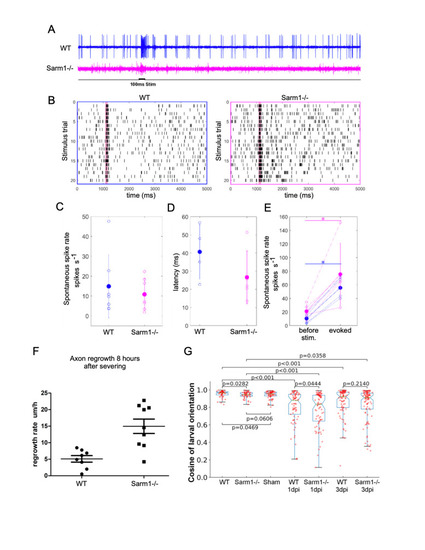- Title
-
Sarm1 is dispensable for mechanosensory-motor transformations in zebrafish
- Authors
- Asgharsharghi, A., Tian, W., Haehnel-Taguchi, M., López-Schier, H.
- Source
- Full text @ MicroPubl Biol
|
Loss of Sarm1 is compatible with mechansensory function in zebrafish: A) Examples of five-second long loose patch recordings of mutant and control larva. Stimulus (water jet): 100 ms. Wild type (blue) Sarm1 mutants (magenta). B) Raster plots of responses to 20 stimulus repetitions in wild type (blue) and Sarm1- mutant larvae (magenta). C) Quantification of spontaneous spike rates from all recorded neurons, averaged over entire recording (12 seconds to 2 minutes). Wild type and Sarm1 mutants show no significant differences (wild type n=7, Sarm1-/- n=7). D) Quantification of response latencies of wild type and mutant larvae shows no significant difference (wild type n=4, Sarm1-/- n=5). E) Wild type and Sarm1 mutants respond with a significant increase in spike rate to water jet stimulation (p<0.05). No significant difference in spike rate was detected between wild type and Sarm1-/- before or after stimulus onset. F) Regrowth rate of lateralis afferent axons in wild type and Sarm1-deficint larval zebrafish 8 hours after laser-mediated severing. G) Rheotaxis (oriented swimming against water-flow direction) shown as cosine of the orientation of the wild-type and Sarm1-/- larva in 6mm/s water flow, showing a marginal difference between wild-type and Sarm1 mutants. * indicates p<0.05, Wilcoxon rank sum test. Wild type n=7 Sarm1-/- n=7. 10 trails for each larvae. Rheotaxis of 7dpf larva in the indicated groups. Sham: sham ablation of the lateralis nerves. 1dpi: 1 day post injury; 3dpi: 3 day post injury. p value were from the Wilcoxon rank sum test. n=7 for each group, 10 trails for each larva. PHENOTYPE:
|

